


N. Masripatin
Indonesia recognizes opportunities and seeks to overcome hurdles in CDM forestry.
Forest land in Indonesia covers about 105 million hectares (FAO, 2001) or almost 60 percent of the country’s land area. Traditionally, many Indonesian people have depended on forest for their subsistence and customary activities. Forestry also generates employment and business opportunities. Within the total population of about 207 million (FAO, 2005), it has been estimated that about 36 million people rely on the forest sector (including both formal and informal) (Ministry of Forestry, 2002).
Between 1990 and 2000, Indonesia lost approximately 1.3 million hectares of its forest per annum (FAO, 2001). Indonesia’s Ministry of Forestry (2003a) estimated that 96.3 million hectares of the country’s land area was degraded, including 54.6 million hectares of degraded forest in need of rehabilitation (Figure 1).
Considerable funding is needed to restore the large area of degraded forest. Current national funds can only support rehabilitation activities on about 3 million hectares from 2003 to 2007, so alternative funding sources for forest rehabilitation need to be explored. The Clean Development Mechanism (CDM) under the Kyoto Protocol, which offers opportunities for developing countries to collaborate with developed countries in the global effort to mitigate negative impacts of climate change through carbon sink projects, may provide support for rehabilitating degraded forest.
Indonesia ratified the Kyoto Protocol in 2004. The country has put into effect some regulatory measures to meet the international requirements to participate in the CDM and has established a Designated National Authority (see Box).
However, no forestry projects have been proposed yet under the CDM in Indonesia. The reasons for this are severalfold. First, the rules and procedures for full-scale forestry projects under the CDM were unclear until the ninth Conference of the Parties (COP-9) of the United Nations Framework Convention for Climate Change (UNFCCC), and those for small-scale projects were only defined at COP-10. (In contrast, rules and procedures for projects outside the area of Land Use, Land Use Change and Forestry [LULUCF] have been clear since COP-7, 2001, and some such projects have been submitted to the National Designated Authority for approval.) Furthermore, the rules and procedures established by the COP decisions could not readily be implemented because of inconsistencies with existing national regulations. Second, there have been difficulties in finding eligible land that meets the CDM definitions for forest, afforestation and reforestation. Third, the complexity of CDM rules and procedures has dampened the interest of project proponents in CDM forestry. Buyers and potential investors have tended to prefer the energy sector over forestry for CDM projects, and those that do invest in forestry may find investing in other projects or activities more profitable than investing in CDM projects.
Nevertheless, considering the potential benefits that CDM forestry could offer in terms of encouraging sustainable forest management practices, Indonesia has undertaken a number of initiatives to support its implementation, relating to both institutional and regulatory aspects and the building of technical capacity. This article describes some of the opportunities, some of the challenges and Indonesia’s approach to reconciling them.
1 |
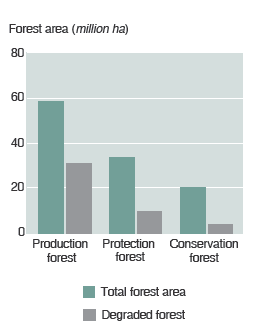 |
Investment in forestry has a long gestation period and high risks. Moreover, the principles of sustainable forest management must be the main consideration in using forest resources. Several UNFCCC COP decisions will facilitate the use of the CDM to promote sustainable forestry in Indonesia.
The broad array of forest industry operations in Indonesia, from pulp and paper to sawn timber, furniture and other downstream industries, calls for a range of raw material which influences choice of species. Pulp and paper industries, for example, choose fast-growing high-yielding species which can be harvested in a short rotation. Such species are generally exotic and potentially invasive. Thanks to the long crediting period decided by COP-9 (a maximum of 20 years which can be renewed twice, for a maximum of 60 years), the Government of Indonesia can use the CDM to encourage the private sector to plant relatively slow-growing, environment-friendly local species, which would otherwise be less attractive financially.
The decision of COP-10 on small-scale CDM projects allows simplified modalities and procedures for forestry projects with a maximum sequestration limit of 8 kilotonnes of CO2 equivalent per year. This type of project will encourage both private landowners and small-scale permit holders on State forest land to participate in the CDM. Smallholders in Indonesia commonly practise agroforestry (intercropping). This type of afforestation scheme can not only help efforts to alleviate poverty, but can also conserve biodiversity and help reach social objectives as recommended under the Convention on Biological Diversity (CBD) and UNFCCC.
CDM projects must be additional to business as usual. Additionality, as long as it is demonstrated from the environmental point of view, can be further defined to suit the national context. In Indonesia, the additionality requirement may help to speed up restoration of degraded lands by directing CDM funding to areas not targeted for rehabilitation programmes between 2003 and 2007 or to heavily degraded forest where additional funds are needed.
Furthermore, as CDM projects are run with strict rules, lessons learned from carrying out CDM projects will be useful in practising sustainable forest management.
Indonesia has been involved in various processes and studies relevant to the CDM at both the international and national levels since the late 1990s. For example, the Indonesian Forestry Research and Development Agency (FORDA) has carried out research in collaboration with the Japan International Coordination Agency (JICA), the Japan International Forestry Promotion and Cooperation Center (JIFPRO) and the Australian Centre for International Agricultural Research (ACIAR). However, most work related to the CDM has addressed only one or two aspects of forestry CDM projects, mainly technical and socio-economic aspects (Gintings et al., 2003), and many stakeholders still have limited awareness of CDM issues. The biggest challenge is in promoting small-scale CDM forestry in which the project can only be implemented by low-income communities and individuals who mostly lack capacity to undertake such projects.
The National Strategy Study on the Clean Development Mechanism in the Forest Sector (Ministry of Environment, 2003), carried out in 2002 with funding from the Australian Government through the World Bank, identified the barriers to CDM implementation in Indonesia which need to be tackled at the national level.
An international rule that creates a technical challenge in Indonesia is the definition of forest, afforestation and reforestation decided by COP-9.
Definition of forest. Non-Annex I countries that wish to participate in the CDM must determine a single value of minimum land area between 0.05 and 1 ha, minimum tree crown cover between 10 and 30 percent and minimum tree height between 2 and 5 m. These values must be fixed for all afforestation and reforestation project activities registered under the CDM prior to the end of the first commitment period. In Indonesia, the values have been fixed as follows: land area of at least 0.25 ha, 30 percent crown cover and 5 m tree height (Ministry of Forestry, 2004). However, the requirement of a single definition of forest for the whole country has considerable influence on the area of land and types of forestry projects eligible under the CDM.
Indonesia has seven forest types by ecological zone: coastal forest, peat forest, mangrove forest, lowland tropical rain forest, savannah, mountain forest and alpine forest. Forms of vegetation and the speed of natural regeneration after disturbance vary among the seven types. Hence, selecting a single value of minimum crown cover, tree height and land area for the whole country to meet the definition of forest significantly reduces the land area eligible for projects under the CDM. For example, most logged-over areas of lowland tropical forests that were harvested before 1990 already meet the definition of forest, except areas invaded by the grass Imperata cylindrica and heavily degraded areas requiring high input for rehabilitation. Savannah, using the adopted definition of forest, would be eligible for afforestation or reforestation under the CDM, but converting savannah to forest that meets the CDM definition would be costly and therefore not attractive for project proponents.
The single definition of forest also limits the types of activity that can be eligible for CDM projects. Indonesia has a wide variety of site conditions (from heavily degraded to highly productive land), species to be planted, land status (private land, forested and non-forested State lands), land functions (production, protection and conservation), socio-economic and cultural conditions and project scales. Accordingly, a range of afforestation practices have long been used. Species composition in agroforestry, for example, ranges from very simple to complex, and plantations can be large, medium or small with a single species or a combination of two or more species. Although many practices could contribute towards the enhancement of carbon sequestration capacity in the country, only a few of the existing afforestation practices may reap the benefits of the CDM.
Definition of afforestation and reforestation. Since projects are only defined as afforestation if the land was non-forested 50 years before the start of the project, only private land is likely to be eligible for afforestation under the CDM, since logging activities in lowland forest areas of major outer islands such as Sumatra, Kalimantan, Sulawesi and Maluku began in the early 1970s. Information on land use (forested or non-forested) in the past 50 years will be more available for privately owned land than for State land.
The definition of reforestation, which is based on non-forested condition since 31 December 1989, will reduce the area of land eligible for the CDM, as existing areas that meet the definition of forest were mostly deforested after 1990. With the economic, social and political crisis of the mid-1990s and increased domestic and international illegal logging and illegal trade, the rate of deforestation has increased from less than 1 million hectares per year in the 1980s to more than 2 million hectares per year in the early 2000s. The problem of non-eligibility of lands deforested and degraded after 1990 is compounded by the fact that most logged-over areas of lowland tropical forests that were harvested before 1990 have already met the definition of forest as described above.
A logged-over area in Indonesia which may not meet the definition of forest and thus not be eligible for the CDM |
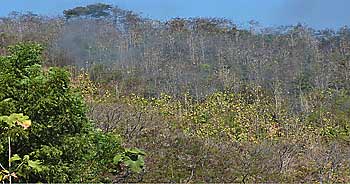 |
CENTRE FOR PLANTATION FOREST RESEARCH AND DEVELOPMENT |
Simple agroforestry with teak (Tectona grandis) in Central Java (above) contrasts with more complex agroforestry with cajuput (Melaleuca cajuputi) (below): the narrow definition of forest may limit the eligibility of the full range of afforestation practices under the CDM |
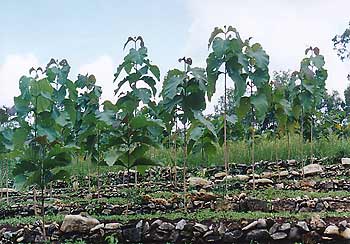 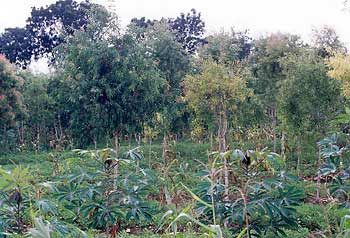 |
CENTRE FOR PLANTATION FOREST RESEARCH AND DEVELOPMENT
CENTRE FOR PLANTATION FOREST RESEARCH AND DEVELOPMENT |
Indonesia recognizes that the CDM offers benefits despite its complicated rules and procedures. It can support the national programme on rehabilitation of degraded forest land and help strengthen the economy of low-income communities, while contributing at the same time to global efforts to reduce the negative impact of climate change. It can be used as an incentive for both large and small forest landholders to practise sustainable forest management voluntarily. On this basis, the following actions have been taken to create enabling conditions for the implementation of CDM forestry in Indonesia.
As mentioned above, the National Strategy Study on the Clean Development Mechanism in the Forest Sector (Ministry of Environment, 2003) suggested that institutional and regulatory barriers were a result of inconsistency between international requirements and relevant forestry regulations in the country. Some regulations in the forest sector were identified to be barriers in implementation of CDM-forestry. Indonesia has tackled these issues through a number of CDM-related regulations.
The Ministry of Forestry (2004) put into effect the Minister’s Regulation P.14/2004 concerning rules and procedures for implementation of CDM forestry in Indonesia. Under this regulation, CDM forestry can be implemented in production and protection forest areas, adat forest (State forest located in traditional jurisdiction areas) and both State-owned and private non-forest land. CDM forestry projects can be implemented in areas that have been granted a permit for forest plantation concession or environmental service concession for carbon trading or in areas with adat forest management rights. For projects on non-forest land, a permit for estate crop plantation is required if the proposed project is to be on State land, or proof of landownership if the proposed project is to be on private land.
Under a 2005 decree of the Ministry of Environment, the process of getting national approval for CDM projects takes 30 days, provided all requirements are met (Figure 2). However, the procedure for applying to the CDM for afforestation or reforestation projects is slightly different than for other CDM projects. While proponents of other types of CDM project may submit a project design document and other necessary documents directly to the Designated National Authority, Minister of Forestry Regulation P.14/2004 specifies that afforestation or reforestation project proponents need first to obtain approval or recommendation from the Ministry of Forestry before they can submit a project design document to the Designated National Authority. The proponent must submit three prerequisites to the Ministry of Forestry:
The Minister of Forestry must provide an approval or recommendation letter to the Designated National Authority explaining that the proposed CDM project will contribute to sustainable development in forestry. However, the passage through the Ministry of Forestry will not add to the total time period for getting approval from the Designated National Authority, since part of the project screening will already have been done by the ministry (Figure 3). Furthermore, since the project concept note needs to include many aspects that are to be covered in the project design document, this procedure will actually reduce the workload in project design document preparation.
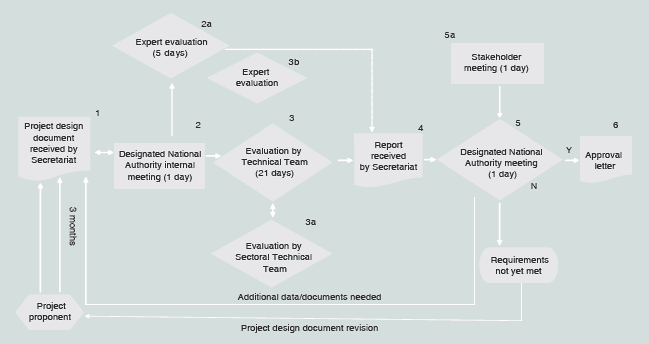 |
3 |
 |
Capacity building is a great challenge. Although various forms of capacity building have been carried out (including participation in courses and workshops), mostly with overseas funding support, since the late 1990s, very few people are sufficiently aware of CDM requirements and issues. On a positive note, a CDM Working Group under the Ministry of Forestry was established in 2000. It facilitates information dissemination on CDM forestry to related stakeholders, provides technical and policy inputs to decision-makers and handles CDM processes in the ministry.
Identification of eligible land for the CDM has been identified in several steps as follows, based on Ministry of Forestry data.
More detailed data on the physical, socio-economic and other necessary data on land eligibility for CDM projects can be obtained at the district level. Under Minister of Forestry Regulation P.14/2004, local government needs to give approval on land eligibility before a CDM project can be developed. Hence, local government is required to have sufficient data and related information for giving approval on land eligibility for CDM funding. It is important to avoid regions prone to forest fire or to land or social conflict.
 |
5 |
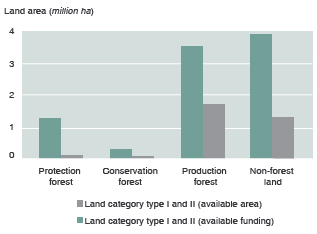 |
A general guide for investors in the CDM is being developed with financial support from the Institute for Global Environmental Strategies (IGES) through the Ministry for Environment. An investors’ guide specific to CDM forestry is also being developed under FORDA–JICA cooperation.
In 2004–2005, under a Government of Indonesia/Asian Development Bank project, project design documents have been prepared for four locations, selected through a participatory process. District governments were represented in several steps of site selection. The sites selected for developing project design documents met land eligibility criteria as well as biogeographical distribution considerations. The commitment of local government to support project preparation and implementation, including the creation of enabling conditions at the local level and management of risks, was also a key consideration in selecting the sites. Through this project, it is expected that CDM forestry in Indonesia can be realized in 2006.
Although the CDM should not be expected to solve countries’ problems of forest degradation, it offers – despite complex rules and procedures – an opportunity for the forest sector in developing countries to obtain additional funding for rehabilitation of degraded lands where domestic funding is lacking. The CDM should be recognized in the forest sector above all for the opportunities it gives stakeholders to participate in large- and small-scale forestry, in other words for giving incentives and providing lessons to encourage private landholders to practise sustainable forestry voluntarily.
 Bibliography
Bibliography
FAO. 2001. Global forest resources assessment 2000 – main report. FAO Forestry Paper No. 140. Rome.
FAO. 2005. State of the World’s Forests 2005. Rome.
Gintings, N., Masripatin, N., Ginoga, K., Daryanto, H., Siregar, C.A., Sarsito, A. & Rosalina, U. 2003. Status Penelitian dan kajian tentang CDM Kehutanan dan Proyek Karbon Berbasi Kehutanan Lainnya di Indonesia. [Research status of CDM on LULUCF and other forest-based carbon projects in Indonesia.] Jakarta, Indonesia, Forest Research and Development Agency (FORDA)/Ministry of Forestry.
Ministry of Environment. 2003. National strategy study on CDM in forestry sector – technical report. Jakarta, Indonesia.
Ministry of Forestry. 2002. Country report on the progress and achievement toward sustainable forest management in Indonesia. Jakarta, Indonesia.
Ministry of Forestry. 2003a. Master Plan Rehabilitasi Hutan dan Lahan. [Master Plan of Forest and Land Rehabilitation.] Jakarta, Indonesia.
Ministry of Forestry. 2003b. National Plan on Forest and Land Rehabilitation, 2003–2007. Jakarta, Indonesia.
Ministry of Forestry. 2004. Peraturan Menteri Kehutanan No. P.14 Tahun 2004 tentang Tata Cara Aforestasi dan Reforestasi Dalam Kerangka Mekanisme Pembangunan Bersih. [Minister of Forestry Regulation No. P.14/2004 concerning rules and procedures for implementation of A/R CDM.] Jakarta, Indonesia.